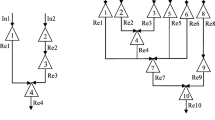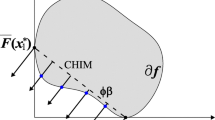Abstract
In oil Reservoir Engineering application, a problem of great interest is the dynamic optimization of waterflooding management. In this work, the net present value (NPV) is taken as the function to be maximized, in which the allocated rates of wells are considered as design variables. Alternatively, the switching times of the control cycles can also be considered as design variables. This assumption increases flexibility to the management. Despite this, the formulation of this problem leads to a highly nonlinear, multimodal objective function. Therefore, to conduct the management, a hybrid optimization strategy is proposed here considering surrogate models. The hybrid strategy combines different methods at two different stages, a global and local. In this sense, the global search is driven by the genetic algorithm (GA) and the local search is driven by the sequential approximation optimization (SAO) method. The proposed methodology was successful in identifying wells that should be late started or shut-in before the end of the concession period and in handling different kinds of production strategies. It was also verified that an increasing on operation flexibility results in NPV improvement. Cycle duration variables proved to be useful in decreasing the number of design variables while maintaining recovery efficiency.







Similar content being viewed by others
Abbreviations
- A :
-
Coefficient matrix of constraints
- b :
-
Right-hand side of constraints
- c w :
-
Cost of produced water
- c wi :
-
Cost of injected water
- f :
-
Objective function
- \( \hat{f} \) :
-
Kriging model (surrogate function for objective function)
- F :
-
Fitness function
- g :
-
Inequality constraints
- \( \hat{g} \) :
-
Kriging model (surrogate function for inequality constraints)
- h :
-
Equality constraints
- \( \hat{h} \) :
-
Kriging model (surrogate function for equality constraints)
- I :
-
Injection wells
- k :
-
Permeability
- n t :
-
Number of control cycles
- n w :
-
Number of wells
- p :
-
Pressure
- P :
-
Producer well
- q :
-
Well rates
- Q :
-
Maximum rate allowed for well set of the field
- r :
-
Oil price
- t :
-
Time step
- T :
-
Concession period
- v :
-
Violation of the constraints
- x :
-
Design variables
- Z :
-
Gaussian function
- α :
-
Ration between maximum production and injection rates
- β :
-
Unknown constant (for Kriging model)
- γ :
-
Penalty parameter
- δ :
-
Over injection parameter
- Δ:
-
Size of the trust region
- Δτ :
-
Time size of control cycles
- λ :
-
Activation parameter
- σ 2 :
-
Variance
References
Horne RN (2002) Optimization application in oil and gas recovery. In: Pardalos PM, Resende MGC (eds) Handbook of applied optimization. Oxford University Press, New York
Jansen JD (2011) Adjoint-based optimization of multiphase flow through porous media—a review. Comput Fluids 46(1):40–51
Brouwer DR, Jansen JD (2004) “Dynamic optimization of waterflooding with smart wells using optimal control theory”, SPE 78278-PA. SPE J. 9(4):391–402
Sarma P, Chen WH, Durlofsky LJ, Aziz K (2008) Production optimization with adjoint models under nonlinear control-state path inequality constraints. SPE Reservoir Eval Eng 11(2):326–339
Chen C, Wang Y, Li G, Reynolds AC (2010) Closed-loop reservoir management on the Brugge test case. Comput Geosci 147(4):691–703
Chen C, Li G, Reynolds AC (2012) “Robust constrained optimization of short and long-term net present value for closed-loop reservoir management”. SPE 141314-PA. SPE J. 17(3):849–864
Cardoso MA, Durlofsky LJ (2010) Linearized reduced-order models for subsurface flow simulation. J Comput Phys 229(3):681–700
He J, Saetrom J, Durlofsky LJ (2011) Enhanced linearized reduced-order models for subsurface flow simulation. J Comput Phys 230(23):8313–8341
Alhuthali AH, Datta-Gupta A, Yuen B, Fontanilla JP (2009) Field applications of waterflooding optimization via rate control with smart wells. In: SPE reservoir simulation symposium, SPE 118948, 18–20 February, The Woodlands, TX
Oliveira DF (2006) Production optimization techniques for petroleum reservoirs: derivative free approaches to dynamic rate allocation for injection and production. Master thesis, Civil Engineering Department, UFPE, Recife, Brazil (in Portuguese)
Almeida LF, Vellasco MMBR, Pacheco MAC (2010) Optimization system for valve control in intelligent wells under uncertainties. J. Pet. Sci. Eng. 73:129–140
Souza SA, Afonso SMB, Horowitz B (2010) Optimal management of oil production using the Particle Swarm Algorithm and Adaptive Surrogate Models. In: XXXI Iberian Latin-American Congress on Computational Methods in Engineering, Buenos Aires, 15–18 November, Argentina
Asadollahi M, Dadashpour M, Kleppe J, Naevdal G (2009) Production optimization using derivative free methods applied to Brugge field. In: IRIS-Gubkin-Statoil-NTNU workshop in production optimization, Torondheim, Norway, 28th September
Queipo NV, Goicochea JV, Pintos P (2002) Surrogate modeling-based optimization of SAGD process. J. Pet. Sci. Eng. 35:83–93
Wang C, Li G, Reynolds AC (2009) “Production optimization in closed-loop reservoir management”, SPE 109805. SPE J. 14(3):506–523
Chen Y, Oliver DS (2010) “Ensemble-based closed-loop optimization applied to Brugge field”. SPE 118926-PA. SPE Res. Eval. Eng. 13(1):56–71
Xia Y, Reynolds AC (2013) An optimization algorithm based on combining finite difference approximations and stochastic gradients. In: SPE reservoir simulation symposium, SPE 163613, 18–20 February. The Woodlands, TX
Zhao H, Chen C, Do S, Li G (2011) Maximization of a dynamic quadratic interpolation model for production optimization. In: SPE reservoir simulation symposium, SPE 141317, 21–23 February. The Woodlands, Texas, USA
Güyagüler B (2002) Optimization of well placement and assessment of uncertainty. Doctor of philosophy thesis, Stanford University, Stanford, CA
Goldberg DE (1989) Genetic Algorithm in Search, Optimization and Machine Learning. Addison-Wesley Publishing Company, Reading, MA
Alexandrov N, Dennis JR, Lewisand RM, Torezon V (1997) A trust region framework for managing the use of approximation models in optimization. NASA/CR-201745, ICASE report no. 97-50
Eldred MS, Giunta AA, Collis SS (2004) Second-order corrections for surrogate-based optimization with model hierarchies. Paper AIAA-2004-4457 in proceedings of the 10th AIAA/ISSMO multidisciplinary analysis and optimization conference, Albany, NY
Horowitz B, Afonso SM, Mendonça CV (2013) Surrogate based optimal waterflooding management. J Pet Sci Eng 112:206–219
Naevdal G, Brouwer DR, Jansen JD (2006) Waterflooding using closed-loop control. Comput Geosci 10:37–60
Van Essen GM, Zandvliet MJ, Van den Hof PMJ, Bosgra OH, Jansen JD (2009) “Robust waterflooding optimization of multiple geological scenarios”, SPE 102913-PA. SPE J. 14(1):202–210
Asadollahi M (2012) Waterflooding optimization for improved reservoir management. PhD thesis, NTNU, Norway
Lorentzen RJ, Shafieirad A, Naevdal G (2009) Closed loop reservoir management using the ensemble Kalman filter and sequential quadratic programming, SPE 119101. In: SPE Reservoir Simulation Symposium, 18–20 February, The Woodlands, TX
Asadollahi M, Naevdal G (2010) Selection of decision variables for large-scale production optimization applied to the Brugge field, SPE 136378. In: SPE Russian oil and gas conference and exhibition, 26–28 October, Moscow, Russia
Horowitz B, Afonso SM, Mendonça CV (2010) Using cycle switching times as design variables in optimum waterflooding management. In: EngOpt—2nd international conference on engineering optimization, Instituto Técnico Superior de Lisboa, Lisbon, Portugal
Keane AJ, Nair PB (2005) Computational approaches for aerospace design: the pursuit of excellence. Willey, Hoboken, 2005, p 602. ISBN 0470855401
Forrester A, Sobester A, Keane A (2008) Engineering design via surrogate modeling: a practical guide. Wiley, Chichester, p 228. ISBN 0470060689
Giunta AA, Wojtkiewicz SF, Eldred MS (2003) Overview of modern design of experiments methods for computational simulations. Paper AIAA-2003-0649, proceedings of the 41st AIAA aerospace sciences meeting and exhibit, Reno, NV
Afonso SMB, Horowitz B, Willmersdorf RB (2008) Comparative study of surrogate models for engineering problems. In: Proceedings of the 7th international ASMO-UK/ISSMO conference on engineering design optimization, Bath, UK
Gen M, Cheng R (2000) Genetic algorithm and engineering optimization. Wiley, New York
Michalewicz Z (1996) Genetic Algorithm + Data Structure = Evolution Programs, 3rd edn. Springer-Verlag, New York
Deb K (2000) An efficient constraints handling method for genetic algorithms. Comput Methods Appl Mech Eng 186(2–4):311–338
Lemonge ACC, Barbosa HJC, Borgesc CCH, Silva FBS (2010) Constrained optimization problems in mechanical engineering design using a real-coded steady-state genetic algorithm. In IX Congreso Argentino de Mecánica Computacional/II Congreso Sudamericano de Mecánica Computacional/XXXI CILAMCE—Congreso Ibero-Latino-Americano de Métodos Computacionales en la Inginería
Deb K (1995) Optimization for Engineering Design: Algorithms and Examples. Prentice-Hall, New Delhi
Reklaitis GV, Ravindran A, Ragsdell KM (1983) Engineering Optimization Methods and Applications. Wiley, New York
Homaifar A, Lai SH-V, Qi X (1994) Constrained optimization via Genetic Algorithms. Simulation 62(4):242–254
Joines JA, Houck CR (1994) On the use of nonstationary penalty functions to solve nonlinear constrained optimization problems with gas. In: Michalewicz Z (ed) Proceedings of the international conference on evolutionary computation. IEEE Press, Piscataway, pp 579–584
Michalewicz Z, Attia N (1994) Evolutionary optimization of constrained problems. In: Sebald AV, Fogel LJ (eds) Proceedings of the third annual conference on evolutionary programming. World Scientific, Singapore, pp 98–108
Schoenauer M, Michalewicz Z (1996) Evolutionary computation at the edge of feasibility. In: Voigt HM, Ebeling W, Rechenberg I, Schwefel H-P (eds) Parallel problem solving from nature, PPSN IV. Lecture Notes in Computer Sciences, vol 1141. Springer, Berlin, pp 245–254
Koziel S, Michalewicz Z (1999) Evolutionary Algorithms, Homomorphous Mappings, and Constrained Parameter Optimization. Evol Comput 7(1):19–44
Souza SA (2012) Optimal management of oil production using particle swarm optimization algorithm and adaptive surrogate models. Master thesis, Civil Engineering Department, UFPE, Recife, Brazil (in Portuguese)
Eldred MS, Giunta AA, Collis SS (2004) Second-order corrections for surrogate-based optimization with model hierarchies. Paper AIAA-2004-4457 in proceedings of the 10th AIAA/ISSMO multidisciplinary analysis and optimization conference, Albany, NY
CMG (2012) User’s Guide. Computer Modeling Group Ltd., Calgary
Silva FT, Rodrigues JP, Paraizo PB, Romeu RK, Peres AM, Oliveira RM, Pinto IA, Maschio C (2005) Novel ways of parameterizing the history matching problem, SPE 94875, SPE Latin American and Caribbean Petroleum Engineering Conference, Rio de Janeiro
Acknowledgments
The authors acknowledge the financial support for this research given by PRH-26, from ANP (National Petroleum Agency—Brazil), PETROBRAS, Foundations CMG, CNPq (National Research Council—Brazil), FACEPE (Support Foundation of Science and Technology of Pernambuco), and UFPE.
Author information
Authors and Affiliations
Corresponding author
Additional information
Technical Editor: Celso Kazuyuki Morooka.
Rights and permissions
About this article
Cite this article
de Oliveira, L.C., Afonso, S.M.B. & Horowitz, B. Global/local optimization strategies combined for waterflooding problems. J Braz. Soc. Mech. Sci. Eng. 38, 2051–2062 (2016). https://doi.org/10.1007/s40430-015-0461-y
Received:
Accepted:
Published:
Issue Date:
DOI: https://doi.org/10.1007/s40430-015-0461-y




